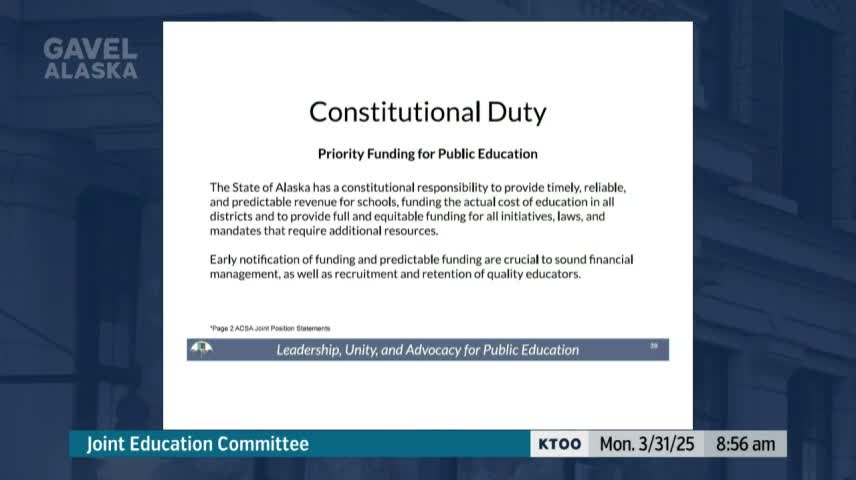Alaska school leaders say flat funding has 'starved' districts, outline cuts under low-budget scenarios
March 31, 2025 | 2025 Legislature Alaska, Alaska
This article was created by AI summarizing key points discussed. AI makes mistakes, so for full details and context, please refer to the video of the full meeting. Please report any errors so we can fix them. Report an error »

Juneau, Alaska — School superintendents and education officials told a joint meeting of the Alaska House and Senate education committees March 31 that flat funding for public education and rising fixed costs have left districts unable to plan and are forcing deep program cuts under lower-budget scenarios.
“Flat funding for over a decade is a cut to my members,” said Lisa Paradis, executive director of the Alaska Council of School Administrators, during the presentation. She urged lawmakers to provide “timely, reliable, and predictable revenue for schools.”
The Kenai Peninsula Borough School District and other large districts have prepared multiple budgets to account for uncertainty, Superintendent Clayton Holland told the committee. He said district leaders had drafted three budget scenarios and that a scenario he described as “680 right now is … a significant cut” would eliminate reading specialists, elementary counselors and shrink distance-education and career programs in his district.
Holland warned that the timing problem compounds the staffing crisis: districts cannot recruit effectively while they do not know how many positions they can fill. “We have 60 staff members who don't know if they have positions next year,” he said, describing how delayed budget certainty forces districts to guess and then build contingency plans.
Alaska school business officials and budget officers also told the committee that rising fixed costs — health care increases, utilities and transportation — have outpaced state formula increases. Katie Parrott, senior director in Anchorage School District’s Office of Management and Budget and president-elect of the Alaska Association of School Business Officials, said only about 74% of district spending goes to instructional functions and that operations and maintenance account for roughly 15% of operating costs.
“Reduction of school bond debt reimbursement has had a noticeable impact to the facility maintenance backlog,” Parrott said, noting that local deferred maintenance and a moratorium on reimbursement have pushed districts into short-term fixes rather than planned repairs.
Committee members pressed presenters about the concrete consequences of low funding. Representative Story asked how lower scenarios would affect the Kenai district; Holland listed programs that would be cut in the more severe scenario and said those cuts would reduce course offerings and student supports. President Stevens urged advocates to press for new revenue, saying the Legislature faces choices between adding revenue and shrinking services.
Why it matters: Witnesses said reduced and uncertain funding has direct consequences for staffing, student supports and district operations, and that delayed decisions amplify recruiting and retention problems. Several presenters emphasized that shortfalls already have forced displacements in large districts and could worsen teacher and administrator turnover if funding remains uncertain.
Ending: Lawmakers said the committee will continue budget and policy work; presenters urged early, formula-based funding increases to allow districts to plan hires and maintain programs.
“Flat funding for over a decade is a cut to my members,” said Lisa Paradis, executive director of the Alaska Council of School Administrators, during the presentation. She urged lawmakers to provide “timely, reliable, and predictable revenue for schools.”
The Kenai Peninsula Borough School District and other large districts have prepared multiple budgets to account for uncertainty, Superintendent Clayton Holland told the committee. He said district leaders had drafted three budget scenarios and that a scenario he described as “680 right now is … a significant cut” would eliminate reading specialists, elementary counselors and shrink distance-education and career programs in his district.
Holland warned that the timing problem compounds the staffing crisis: districts cannot recruit effectively while they do not know how many positions they can fill. “We have 60 staff members who don't know if they have positions next year,” he said, describing how delayed budget certainty forces districts to guess and then build contingency plans.
Alaska school business officials and budget officers also told the committee that rising fixed costs — health care increases, utilities and transportation — have outpaced state formula increases. Katie Parrott, senior director in Anchorage School District’s Office of Management and Budget and president-elect of the Alaska Association of School Business Officials, said only about 74% of district spending goes to instructional functions and that operations and maintenance account for roughly 15% of operating costs.
“Reduction of school bond debt reimbursement has had a noticeable impact to the facility maintenance backlog,” Parrott said, noting that local deferred maintenance and a moratorium on reimbursement have pushed districts into short-term fixes rather than planned repairs.
Committee members pressed presenters about the concrete consequences of low funding. Representative Story asked how lower scenarios would affect the Kenai district; Holland listed programs that would be cut in the more severe scenario and said those cuts would reduce course offerings and student supports. President Stevens urged advocates to press for new revenue, saying the Legislature faces choices between adding revenue and shrinking services.
Why it matters: Witnesses said reduced and uncertain funding has direct consequences for staffing, student supports and district operations, and that delayed decisions amplify recruiting and retention problems. Several presenters emphasized that shortfalls already have forced displacements in large districts and could worsen teacher and administrator turnover if funding remains uncertain.
Ending: Lawmakers said the committee will continue budget and policy work; presenters urged early, formula-based funding increases to allow districts to plan hires and maintain programs.
View full meeting
This article is based on a recent meeting—watch the full video and explore the complete transcript for deeper insights into the discussion.
View full meeting
